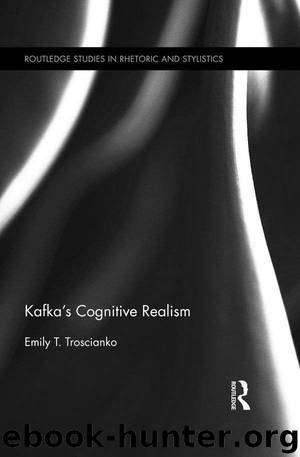Kafka's Cognitive Realism (Routledge Studies in Rhetoric and Stylistics) by Emily Troscianko

Author:Emily Troscianko [Troscianko, Emily]
Language: eng
Format: epub
ISBN: 9781136180040
Publisher: Taylor and Francis
Published: 2014-02-03T00:00:00+00:00
2. Linguistic Means of Engaging the Reader
I outlined in Chapter One reasons for concluding that in visual perception we don’t build up representations of the world by gradually “filling in the gaps”, and have now suggested that in reading Der Proceß we don’t fill in the textual gaps to create nicely coherent mental models of the scenes described. We’re given information of such a nature that this “filling-in” of the gaps can remain at the stage of instinctively assuming that we’re able to do so, being (more or less) confident that, if we chose to, we could “see” K.’s bedroom in all its fully furnished, clearly delineated, accurately dimensional glory. This imaginative confidence is the exact parallel of that perceptual confidence which constitutes the feeling that we really are, at any given moment, seeing all of the world around us.
The notion of gap-filling—whether or not it happens, and how— features in literary theory too: Ingarden (e.g., 1965, 266–70) suggests that gap-filling is a ubiquitous component of all literary reading. For Ingarden, since the imagined objects in literary texts can be evoked only incompletely, from limited perspectives, there inevitably arise “Unbestimmtheitsstellen” (spots of indeterminacy), or “Lücken” (gaps) which, even if not “consciously” noticed, compel an active response in the reader of completion or concretisation. He stresses that the gaps are not filled mechanically, but are, as Peter Zima puts it, using Kafka’s Proceß as his example, the “Ausgangspunkt für eine produktive Tätigkeit” (starting point for a productive activity; 1991, 255). Wolfgang Iser’s (1972) notion of “Leerstellen” (empty places, gaps) develops Ingarden’s thoughts further, but neither pays much attention to the fact that lots of gaps may just not need filling. Yet, given that our engagement with real objects does not involve such concretisation, and that imagination is so closely connected to vision, active input by the reader leading to total cognitive specification of perceptual features (“filling in” all Dennett’s Marilyns one by one) may be seen as the exception rather than the norm. Some Kafka criticism has drawn attention to the fact that Kafka’s texts contain gaps that are essentially unfillable: James Phelan (2011) draws on rhetorical theory to analyse “Das Urteil” (The Judgement) in terms of the distinction between mere “determinate ambiguity” and the stronger textual “stubbornness” (32) of the “unfillable gap” (29, see also 24). Although Phelan’s focus is on more interpretively salient gaps than the present discussion, his insight that Kafka’s narratives may prevent habitual gap-filling activities at the levels of character, motivation, and event is closely related to the notion that they may simply not require such gap-filling in the context of perception.
The potentiality of the fictional world and its events being given in their entirety is enough to allow us to experience them as really given—and our cognitive resources of scripts for likely scenarios are a crucial part of the way in which the minimal information of the text can create the effect of imaginative sufficiency. In general, readers do as little as they can get
Download
This site does not store any files on its server. We only index and link to content provided by other sites. Please contact the content providers to delete copyright contents if any and email us, we'll remove relevant links or contents immediately.
| Books & Reading | Comparative Literature |
| Criticism & Theory | Genres & Styles |
| Movements & Periods | Reference |
| Regional & Cultural | Women Authors |
4 3 2 1: A Novel by Paul Auster(11048)
The handmaid's tale by Margaret Atwood(6852)
Giovanni's Room by James Baldwin(5878)
Big Magic: Creative Living Beyond Fear by Elizabeth Gilbert(4723)
Asking the Right Questions: A Guide to Critical Thinking by M. Neil Browne & Stuart M. Keeley(4574)
On Writing A Memoir of the Craft by Stephen King(4213)
Ego Is the Enemy by Ryan Holiday(3991)
Ken Follett - World without end by Ken Follett(3972)
The Body: A Guide for Occupants by Bill Bryson(3800)
Bluets by Maggie Nelson(3710)
Adulting by Kelly Williams Brown(3670)
Guilty Pleasures by Laurell K Hamilton(3586)
Eat That Frog! by Brian Tracy(3514)
White Noise - A Novel by Don DeLillo(3434)
The Poetry of Pablo Neruda by Pablo Neruda(3366)
Alive: The Story of the Andes Survivors by Piers Paul Read(3310)
The Bookshop by Penelope Fitzgerald(3225)
The Book of Joy by Dalai Lama(3217)
Fingerprints of the Gods by Graham Hancock(3212)
